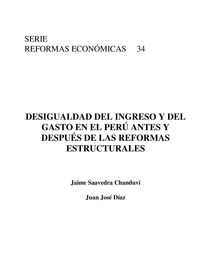Desigualdad del ingreso y del gasto en el Perú antes y después de las reformas estructurales
| Year | : | 1999 |
|---|---|---|
| Author/s | : | Jaime Saavedra, Juan Jose Diaz |
| Area/s | : | Employment, productivity and innovation, Poverty and equality, State reform and public institutions |
Saavedra, J. y Díaz, J. J. (1999). Desigualdad del ingreso y del gasto en el Perú antes y después de las reformas estructurales. Santiago: CEPAL. Reformas Económicas, 34.
Using information from different household surveys, we find that income inequality declined in the period after the start of structural reforms in 1991, continuing a trend observed since 1971.
This result is robust to the use of different variables – total income, total per capita income, per capita expenditure and hourly labor income, as well as to the use of different summary measures of inequality. In general, the available evidence suggests a trend towards a reduction in inequality, both in periods of increasing and decreasing poverty. Despite the reduction in income dispersion, the poverty rate in the 1990s continues to be very high, reaching almost half of the population; on the other hand, fluctuations in per capita national income and per capita product have been similar to those of real incomes of wage earners and the self-employed, and there is no evidence of an increase in the share of capital in total income. We analyze the relationship between the level and changes in inequality with the ownership of physical assets and human capital, and with the returns to some of these assets.
In urban areas, income differences between individuals with different levels of education are the most important element in explaining inequality, followed by differentials by occupation and age or experience. However, it is the reduction in income differences within these groups that explains most of the reduction in overall income inequality. Because of this, we observe the particularity that in the 1990s, income dispersion is reduced despite the fact that returns to education increase. In rural areas, the most important variables in explaining inequality are land and livestock assets, followed by family size and education.







